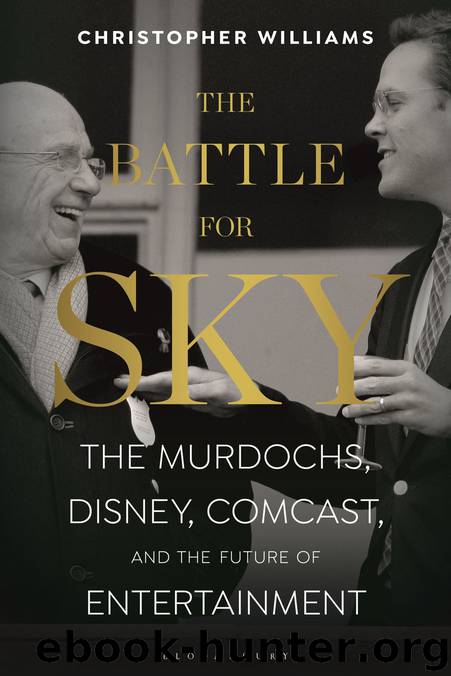The Battle for Sky: The Murdochs, Disney, Comcast and the Future of Entertainment by Christopher Williams

Author:Christopher Williams [Williams, Christopher]
Language: eng
Format: epub
Published: 2020-06-13T23:11:57+00:00
10
The Whole Organisation Was in a State of Shock
Ofcom’s decision in 2010 to impose an obligation for the wholesaling of Sky Sports was a major victory for BT.
Three years into its attempt to challenge Sky in pay-TV, BT had a customer base of fewer than half a million subscribers. With Sky Sports and top-flight football now on offer at a controlled price, it believed it could make a real dent in the market dominance of its former partner. Murdoch and Darroch were furious but agreed a deal with Ofcom under which BT would pay the difference between the capped price and the price they wanted to charge for Sky Sports into an escrow account, pending a High Court challenge.
The man in charge of BT’s renewed attack on Sky was Gavin Patterson, the new head of its retail division. Ian Livingston, who remained bitter about Murdoch’s plotting on broadband when he was in the job, was promoted to BT chief executive and was determined to strike back against Sky.
“Not having Sky Sports has cost us customers,” Patterson said.¹ “We reckon one in two customers we have approached in the last two years turned us down, saying ‘Great service but sorry, pal – no Sky Sports, so we’re washing our hands of you’.”
Sky Sports did not prove to be the boost that BT’s fledgling television business required, however. Over two years it grew by just 200,000 subscribers, in part because the BT Vision set-top box, based on a system provided by Microsoft, was already proving to be outdated. It was not as user-friendly as Sky and, perhaps more importantly, lacked integration with mobile apps. In late 2011, to make matters worse, Netflix made its UK debut, its slick menus and smart recommendations only serving to underline the lack of progress that BT Vision had made.
Livingston’s faith in pay-TV as a central plank of BT’s strategy was nevertheless as strong as ever. It had to be. In the depths of the recession that followed the financial crisis, he had convinced the BT board to invest £2.5bn in a nationwide broadband network upgrade programme. New street cabinets would provide faster and more reliable links to local telephone exchanges for millions of homes.
The plan was bold but soon met with some significant challenges. BT’s network division, Openreach, struggled to convince the company’s rivals in the retail broadband market to sell the new services. Sky and TalkTalk had invested in their own equipment in local exchanges that delivered juicy profit margins. They forecast that most consumers would be happy with their existing broadband connection for years to come and that there was no reason for them to help BT recoup its outlay on network upgrades.
BT needed to sell faster broadband to its own customers, and quickly, and Livingston believed pay-TV offered the answer. He planned to replace BT Vision with a new service based on YouView, a set-top box joint venture alongside the BBC, ITV, Channel 4 and TalkTalk, among others, which aimed to leapfrog Sky’s satellite technology with advanced features only made possible by video streaming.
Download
This site does not store any files on its server. We only index and link to content provided by other sites. Please contact the content providers to delete copyright contents if any and email us, we'll remove relevant links or contents immediately.
| Consulting | Entrepreneurship |
| Franchises | Home Based |
| Marketing | New Business Enterprises |
| Nonprofit Organizations & Charities |
Pioneering Portfolio Management by David F. Swensen(5649)
Zero to One by Peter Thiel(4895)
Man-made Catastrophes and Risk Information Concealment by Dmitry Chernov & Didier Sornette(4817)
The Motivation Myth by Jeff Haden(4579)
The Miracle Morning by Hal Elrod(3960)
Elon Musk by Ashlee Vance(3491)
The Art of Persistence: Stop Quitting, Ignore Shiny Objects and Climb Your Way to Success by Michal Stawicki(3384)
Unlabel: Selling You Without Selling Out by Marc Ecko(3022)
Urban Outlaw by Magnus Walker(2981)
Delivering Happiness by Tony Hsieh(2958)
Purple Cow by Seth Godin(2731)
Mastering Bitcoin: Programming the Open Blockchain by Andreas M. Antonopoulos(2548)
The Content Trap by Bharat Anand(2523)
The Marketing Plan Handbook: Develop Big-Picture Marketing Plans for Pennies on the Dollar by Robert W. Bly(2446)
The Power of Broke by Daymond John(2408)
The Airbnb Story by Leigh Gallagher(2403)
Applied Empathy by Michael Ventura(2355)
Radical Candor by Kim Scott(2267)
Keep Going by Austin Kleon(2196)
